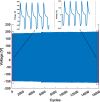3D printed CNT/TPU triboelectric nanogenerator for load monitoring of total knee replacement
- PMID: 40546887
- PMCID: PMC12177930
- DOI: 10.1088/1361-665X/ade1ba
3D printed CNT/TPU triboelectric nanogenerator for load monitoring of total knee replacement
Abstract
This study presents the development and characterization of a novel triboelectric nanogenerator (TENG) designed as a self-powered sensor for load monitoring in total knee replacement (TKR) implants. The triboelectric layers comprise a 3D-printed thermoplastic polyurethane (TPU) matrix with carbon nanotube (CNT) nanoparticles and kapton tape, sandwiched between two copper electrodes. To optimize sensor performance, the proposed CNT/TPU TENG sensor is fabricated with varying CNT concentrations and thicknesses, enabling a comprehensive analysis of how material composition and structural parameters influence energy harvesting efficiency. The 1% CNT/TPU composite demonstrates the highest power output among the tested samples. The solid CNT/TPU-based TENG generated the apparent output power of 4.1 µW under a cyclic compressive load of 2100 N, measured across a 1.6 GΩ load resistance and over a nominal contact area of 15.9 cm2, while the foam CNT/TPU film achieved a higher apparent output power of 6.9 µW measured across a 0.9 GΩ load resistance with the same nominal area. The generated power is sufficient to operate a power management and ADC circuit based on our earlier work. The sensors exhibit a stable open-circuit voltage of 320 V for the foam layer and 275 V for the solid one. Sensitivities are 80.50 mV N-1 ( N) and 24.60 mV N-1 (> 1600 N) for foam CNT/TPU film, demonstrating the integrated sensor capability for wide-range force sensing on TKR implants. The foam CNT/TPU-based TENG maintained stable performance over 16 000 load cycles, confirming its potential for long-term use inside the TKR. Additionally, the dielectric constant of the CNT/TPU composite was found to increase with increasing CNT concentration. The proposed CNT/TPU TENG sensor offers a broad working range and robust energy-harvesting efficiency, making it appropriate for self-powered load sensing in biomedical applications.
Keywords: 3D printing; additive manufacturing; carbon nanotubes; foam TPU printing; pressure sensor; smart knee implant; triboelectric nanogenerator.
© 2025 The Author(s). Published by IOP Publishing Ltd.
Figures












Similar articles
-
A Carbon Nanotube-Doped Polyurethane Nanocomposite-Based Triboelectric Nanogenerator: A Platform for Efficient Mechanical Energy Harvesting and Self-Powered Motion Sensing.ACS Appl Mater Interfaces. 2025 Jul 2;17(26):38469-38480. doi: 10.1021/acsami.5c05754. Epub 2025 Jun 21. ACS Appl Mater Interfaces. 2025. PMID: 40543079
-
Performance of piezoelectric and triboelectric transducers under gait loading for energy harvesting and load monitoring in total knee replacements.Nano Energy. 2025 Aug;141:111117. doi: 10.1016/j.nanoen.2025.111117. Epub 2025 May 11. Nano Energy. 2025. PMID: 40896301
-
Transfer-Printed Wrinkled PVDF-Based Tactile Sensor-Nanogenerator Bundle for Hybrid Piezoelectric-Triboelectric Potential Generation.Small. 2025 Jul;21(26):e2502767. doi: 10.1002/smll.202502767. Epub 2025 May 8. Small. 2025. PMID: 40343397 Free PMC article.
-
Home treatment for mental health problems: a systematic review.Health Technol Assess. 2001;5(15):1-139. doi: 10.3310/hta5150. Health Technol Assess. 2001. PMID: 11532236
-
Foam dressings for treating pressure ulcers.Cochrane Database Syst Rev. 2017 Oct 12;10(10):CD011332. doi: 10.1002/14651858.CD011332.pub2. Cochrane Database Syst Rev. 2017. PMID: 29025198 Free PMC article.
References
LinkOut - more resources
Full Text Sources
